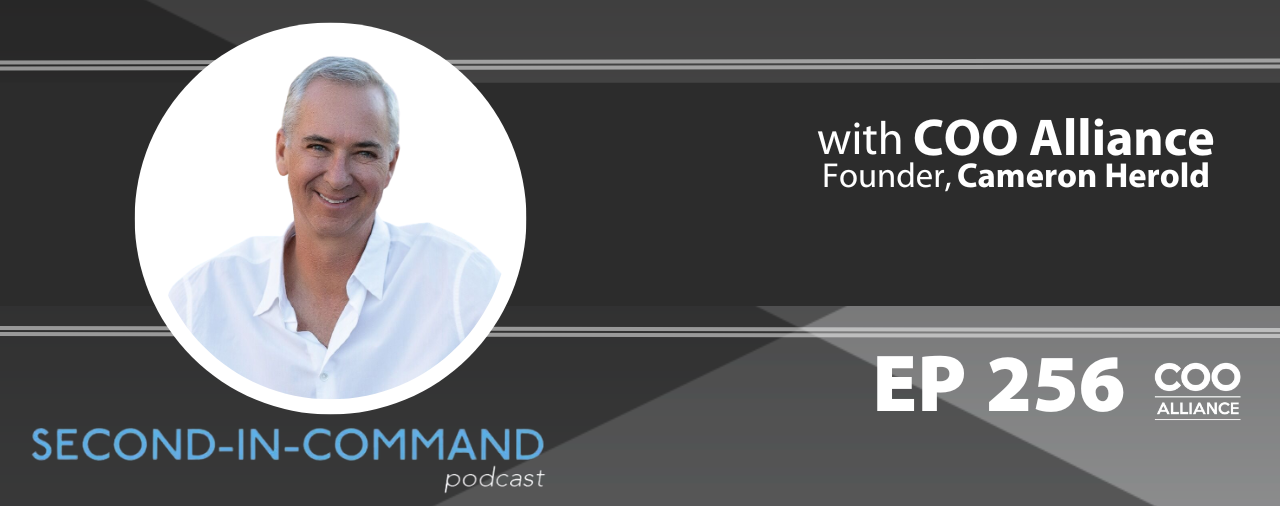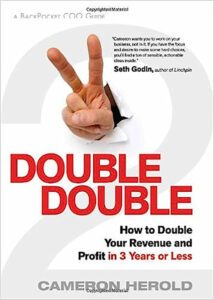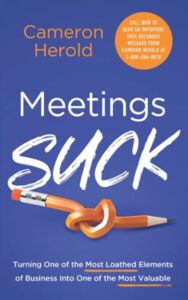Today’s episode features an interview Cameron did as part of the Strategy and Leadership podcast with Anthony Taylor.
During the discussion, Cameron explains the point where a business needs a second in command: Specifically, when a business grows to the point where it can’t handle the people and is missing opportunities. Many entrepreneurs make the mistake of hiring one too soon. He explains why he believes a second in command needs to be able to oversee and lead the employees, without needing to know how to do everyone’s job. They take ideas out of the CEOs mind, organize them, and help decide which ideas to green, yellow, or red light. This means asking a lot of questions and putting systems in place to start projects. Cameron shares some of his ‘aha’ moments, such as his realization that a quickly growing company will easily outgrow the skills of its managers and leaders unless they are replaced or trained as you grow. He explains his belief that entrepreneurs need to lean out 2-3 years into the future, and if the company is going to be bigger, managers need to be given the skills they need to lead. He also provides the thinking behind the COO Alliance: Namely that there was no network for the second in commands with a minimum of $5 million in revenue. Now, the COO Alliance has members in 17 countries.
In This Conversation We Discuss:
- The role of the second in command in a business.
- Cameron’s biggest ‘aha’ moments after helping build four companies.
- The importance of growing the skills of your managers.
- The power of continuous learning and the COO Alliance.
Resources:
Connect with Cameron: Website | LinkedIn
Get Cameron’s latest book “Second in Command: Unleash the Power of your COO”
Subscribe to our YouTube channel – Second in Command Podcast on YouTube
Get Cameron’s online course – Invest In Your Leaders
—
I am so grateful to be joined by Cameron Herold. Cameron, how are you?
Anthony, thanks for having me. I appreciate it.
He’s a fellow BC person living in BC. Cameron is the Founder of the COO Alliance. He’s authored 5 books and I have read 3 of them. He’s a big, foundational part of the Vancouver ecosystem and was a longtime COO for 1-800-GOT-JUNK? He’s been involved with so many organizations. Cameron, anything that you want to add in there to share about your bio and your background before we get into the interview?
1-800-GOT-JUNK? was the fourth company that I built. I had been the second in command a couple of other times, built the largest collision repair chain in North America, and was on the very senior leadership team of what became the largest residential house painting company in the world. We built a private currency company that we built and sold, similar to what Bitcoin is doing, but we did it many years ago and sold it for $64 million.
1-800-GOT-JUNK? was my fourth kick at the can. I left there many years ago, and I’ve been coaching real companies, typically 55 employees from all over the world. I’ve done paid speaking events now in 26 countries on 6 continents. I’ve been booked to speak in Antarctica, which will be my 7th and final continent in February 2023, which will be cool. That’s a little bit about me. I’m a kid from Northern Canada.
I appreciate that. Again, having followed your career for such a long time, you’re A) No BS and B) Bringing a different perspective that I appreciate. There’s a lot of stuff catered to by the CEO, but the COO requires a unique set of skills. It’s a different perspective. It’s a different approach. It’s a little bit less glorified, but it’s so critical to the success of high-growth companies, having, keeping the wheels on the bus, and then sometimes being the other side of the CEO. Maybe you can, as we get into it, speak about the relationship between the CEO and the COO and why is it such a critical role in a growing company.
It’s why I even started the COO Alliance. First off, let’s not call it a COO. We’ll call it a second in command. You’ve got your entrepreneur and then you have the second in command, the integrator, or COO. It could be a Director of Operations, general manager, or VP of Operations. It might be a CFO or a CMO. There’s usually a person that is the second in charge of the CEO. Almost if the entrepreneur was in the hospital for six months, who would be running the company for you? Brian was the Founder and CEO of 1-800-GOT-JUNK? We were best friends. He needed to know what had to happen, what have happened to build the company, but I needed to know how to do it.
Brian needed to be aware that there was something called coaching. I had to know the expertise of coaching. Brian had to know that there was something called situational leadership. I had to understand it and be able to execute situations. He had to know that SEO existed. I had to know where to find people to do it. The role of the COO is more of the who, what, when, where, why, why, and how. The CEO is the where-we’re-going and why-we’re-going-there-person. They’re very much that yin and yang, the almost a husband and wife in a traditional marriage might be.
I looked at your COO Alliance stats and looking at the second in command, many of those businesses, they’re $11 million, $20 million, and above. I could ask it from two perspectives. Smaller businesses that are growing and even bigger businesses might not have a second in command. What happens if you don’t have that in place?
The first thing before you ever hire a second in command an entrepreneur needs to hire is an executive assistant. If you don’t have an executive assistant, you are one. Too often, the entrepreneur tries to hire a second in command to get a bunch of stuff off their plate, but what they can do is get an executive assistant for $60,000 or $50,000 to get a bunch of stuff off their plate, to free them up to work on the bigger, more impactful areas of the business. When the business scales to such a point that they can’t grow their people, they can’t handle all the moving parts and missing opportunities, that’s when you need the second commander to help you leverage the organization truly. In some cases, they tend to bring on the person too early.
Your first management team usually is a jack of all trades, a master of none. You start getting good project managers, people managers, “This person might be good in marketing. We’ll let them run marketing.” Usually, you need a COO when you’re moving your management team to become a leadership team, when you’re bringing in people that have talent, that have skills that you need to oversee them without having any idea how to do their job.
I had a head of product. I couldn’t do product development. I had a head of marketing. I didn’t understand 90% of what they were doing. Integrating with IT, I didn’t understand. I had a head of the call center. I couldn’t do any of the technical in the call center. All of my direct reports were way stronger in the functional areas of the business, but that was because we were then building out those layers.
You touched on a little bit about the evolution from management to leadership, but what were some of the biggest a-ha moments in any of the four businesses that you went through as you developed as a leader yourself?
One of the big ones is in growth. I term hypergrowth as 100% growth year after year. At 1-800-GOT-JUNK? we doubled the size of our revenue for six consecutive years in a row. That’s hypergrowth. Now, I thought that was hypergrowth until I listened to some people at Google, and they did 400% revenue growth 5 years in a row. I’m like, “100% slow.”
In the book, Double Double, I talked about doubling the size of your revenue and profit in three years or less. That’s three 26% growth years, year after year, which is usually called hypergrowth. In growing the size of your company quickly, you have to grow the talent and the skills of your team because if you don’t grow the skills of your managers and leaders, you’ll outgrow them. You’re having to replace them. It’s tough bringing in people from the outside over top of teams. The key is if you can keep growing your people as you grow the company, you don’t need to replace them as often or have to go through those tougher strategic moves. That was one big a-ha.
The second big a-ha was the more that we focus on the critical few things versus the important many, it was about saying no to lots of opportunities and saying yes to the right ones. It was about looking at our people, our time, and our money as the 3 inputs and what’s the highest ROI of those 3 inputs. It was saying yes to those highest ROI things. The momentum created momentum.
I’m taking it from the second-in-command perspective. Working as somebody who’s typically operations-focused and you have to partner with the CEO who is typically vision-focused, how did you maneuver the, “We need to prioritize. We need to focus,” with somebody who may, and I’m not saying Brian did, have shiny object syndrome and was focused on the big picture?
Here’s what was interesting about Brian and I. We were nitroglycerin. We were both very entrepreneurial DNAs, both very entrepreneurial archetypes and personality profiles. I had built a lot of the functional skills to be a COO. I’m a very unique COO in that I’m extraordinarily entrepreneurial DNA. Most COOs though tend to ask a lot of questions and put a lot of systems in place to start projects.
Most entrepreneurs start them and figure it out as they go. Shooting from the hip, winging it, momentum creates momentum. The way that the COO works well with the CEO and the CEO has that big great idea to say, “I love that idea. Let me ask you some questions to understand that idea more so that we can figure out how to get it going.”
If I come to you with a good idea, it’s not to say, “How’s this going to work? How’s that going to work?” They feel like you’re debating them. What they want to do is get the idea out of their mind. Picture the entrepreneur’s mind as a hard drive that keeps getting full. Your job is to take stuff out of their mind and understand it enough that you can put it into a list.
Once a quarter, once every six months, vote on which things to take off the list and to start. Don’t let the entrepreneurs start every idea. The reason they want to start every idea isn’t because they want to start it. It’s because they need to get it out of their mind and onto somebody else’s plate. The middle step is to get it out of their mind, clarify it, get it onto a list, and then take the list every 3 to 6 months and vote on which things to green light, yellow light, or red light.
Is that a formal process, the green light, yellow light, and red light?
It’s a process that I created. Sometimes it’s, “No.” Sometimes it’s, “Not now.” Sometimes it’s, “Okay. Green light. We’re going to do it. Where are we going to do it this quarter? Who’s going to do it? What are the resources?”
I want to highlight something that you shared that is gold there both for leadership teams and for the CEO to recognize those traits in yourself. If you’re a leadership team and you’re working with a CEO, being able to recognize that they need to get shit out of their brains so that they can focus. As a CEO, recognize that your hard drive does get full and sometimes you need to get somebody to get it off your plate. Both of those things are going to help that balance. Any thoughts on that?
The big thing that the CEO needs to do for the COO is to give them time and space to ask questions. Give them time and space to catch up. Remember that you, as the entrepreneur, have been rolling this idea around your head for 3 days, 3 weeks, or 3 months. You can’t hand it to them in seventeen seconds and expect them to get it. They need to ask questions. They’ll ask 10 questions whereas you might only ask 1 or 2 because you’ll ask all your questions as you’re doing it. Give them the space to ask questions.

Manager’s Skills: The CEO needs to give the COO time and space to ask questions. Give them time and space to catch up.
For the COO type, when the entrepreneur says, “I don’t care. I don’t need that,” they’re not saying that they don’t care about the information. What they’re saying is their brain is too full. They trust and respect you so much that they know that you can take care of those details. They don’t have the ability to sort through right now. You need to give them the executive summary. Entrepreneurs want the executive summary and then they’ll ask you for more information if they need it. On the flip side, entrepreneurs need to give the COOs time to ask enough questions to create the system or plan to get going so they don’t have to come back to you seven times.
Two critical ingredients there are the time and space to ask questions. One that sometimes gets overlooked but gets blown into culture is trust and respect. If you don’t have trust and respect between your leadership team, nothing moves. It’s a frustrating experience.
Let me speak to the trust part. The COO’s job is to make the CEO look good. It is to make the CEO iconic. My job was to make Brian look like the shining star at 1-800-GOT-JUNK? It was to take all the tough decisions off his plate, to take all the hard work off his plate to allow him to be vision and culture. Brian’s job behind the scenes with the employees was to make sure that people still like me even though I had to be the hard-ass all the time. His job is like Mom had to make Dad look good and Dad had to make Mom look good. Behind the scenes, Mom and Dad can argue and fight, but not in front of the kids. That’s important for the CEO and COO as well.
This is a small tangent but there was a point when 1-800-GOT-JUNK? got to $100 million and you’re like, “There had to be a change.” It is a tough part to be able to say, “What is that next step in the business?” I couldn’t imagine what that was from a leadership perspective.
I didn’t say there had to be a change. Brian pulled me aside one morning and said, “We’re done.” I said, what do you mean? He said, “We’ve come to the end of your time. You’re not the guy to take us to the billion dollars. You were the guy to get us from $2 million to $100 million.” I started sobbing and he booked me a taxi from the Vancouver Club back to my house. I wasn’t capable of driving. That was a brutal time. He was right. I was the 6th of 6 leadership team members that we had to replace over the prior 3 years. I was the last one on the team.
Of the team of 6 that got us from $2 million to $30 million, 3 of them couldn’t get us to $60 million. A couple of them couldn’t get us to the $100 million. I was the last one that could get us to that stage. We replaced the Head of IT. We replaced the Head of Finance. We replaced the Head of Marketing. We replaced the Head of our Call Center. Each person had to be eventually replaced because they didn’t have the skills to run.
I’m not the billion-dollar guy. They needed someone who could deal with the matrix decision-making and be more methodical, strategic, and detail-oriented. It could slow things down. I was like, “Let’s do Australia. Let’s do the UK. Let’s add 5 to 13 other companies.” It was the perpetual motion machine that I could pull all together to a point. We had 3,100 employees system-wide when I left. We had fourteen when I got there.
One of the things that you mentioned when we were talking about the Double Double was the talent and skills. I was going to ask if you don’t have those because, especially in smaller startup businesses, they feel attached and they feel like, “We’re not going to be able to get the talent, especially now in 2021.” What do you say if your management team doesn’t have the talent and skills that you want? Do you sweep it under the rug and let it go? Do you need to make that call?
What’s beautiful right now is that everything is available. It’s not a how problem. It’s a who problem. It’s not a, “How do I do this?” It’s, “Who can I get to do this?” We can outsource. You can get freelancers. You can get fractional people. It’s pretty easy to get people or businesses to do stuff that needs to get done. It needs to get done, but not by us.
The other thing is entrepreneurs need to lean out into the future 2 or 3 years out and see what their company looks like, acts like, and feels like to see what the team’s going to need. The reason I even launched this course called Invest in Your Leaders was the teams need to grow managers. If we know the company’s going to be bigger in a couple of years, our team’s going to need more skills than they have. We need to give them the skills around coaching. We need to give them the skills around situational leadership. We need to give them the skills around interviewing.

Manager’s Skills: Entrepreneurs need to lean out into the future and see what their company looks like, acts like, and feels like to see what the team is going to need.
Most managers interview new employees, but they’ve never been trained on how to do a job interview. Most managers run meetings, but they’ve never been trained on how to run meetings. Most managers do one-on-one coaching, but they’ve never been trained on how to run one-on-one sessions. They don’t have a clue how to do any of it.
They might understand marketing, but they don’t know how to be a leader or a manager. We need to lean out and give them those skills. The more that we give them the skills and the praise for what they’re doing well, that raises their confidence. They’re more willing to learn more skills, and we keep giving them praise. It’s to grow their skills and confidence, the same way that you grow children.
It’s an undertone to our conversation so far that is both obvious but people miss it. When people look at people, they see potential. They’re like, “This person can do this,” but if they don’t have the skills or experience, it doesn’t mean crap.
Most entrepreneurs also don’t have the skills to teach them. It’s a bit of the blind leading the blind. I had an entrepreneur a few years ago that I coached from 40 employees up to 700. I taught him a session that’s in the Invest in Your Leaders course on email management. He goes, “This is going to change the company.” I said, “No, Bobby. It changes you but you training all of your employees on this system, that will change the company.” The entrepreneur getting better doesn’t magnify the entire organization on its own. Sometimes it magnifies more of the problems.
I want to say something so much gold like, “Teams need to grow their managers, and managers need to grow their leaders” It’s one of those obvious-sounding things but our readers dissect that. Teams need to grow their managers. Managers need to grow into leaders. Expand on that. What does that mean?
My belief is that a leader’s core job is to grow people. Our job is to grow their skills and their confidence continually. It’s not to hold them accountable. Hire accountable people, and learn how to hire accountable people. It’s not to align them. Put the systems in place so they self-align. We’re trying to do it backwards. I believe the org chart should be flipped upside down where the CEO is at the bottom supporting the VPs, who are supporting the managers, supporting the employees, who are supporting the customers, almost an inverted pyramid. Everyone can see the vivid vision of where we’re going.
You build the company inside your core purpose and your core values. That’s how I believe. The leaders and managers have to be always looking ahead to go, “What are the projects that everybody’s working on? Do they have the skills to do that project? Do they have confidence in that project? What about this project? Do they have the skills for that project?” If you don’t have the internal depth, how can you get them the training? Is there a book, a video, a course, or a mentor to keep growing them along that path?
I want to ask you about the COO Alliance and peer learning. Before I do that, you had mentioned the importance of time and space to ask questions. Some might say meetings suck. How do we balance not having too many meetings, and also making the time to unpack stuff that needs to be unpacked?
That book Meetings Suck is based on that same entrepreneur in Florida that I coached from 40 up to 700 people. We were talking one day about his meetings and he said, “Our meetings suck.” I said, “Have you ever trained your managers on how to run meetings?” He said, “No.” I said, “Have you ever trained your employees on how to show up, attend, and participate in meetings?” He said, “No.”
I said, “Meetings don’t suck. You guys suck at running meetings.” He started laughing and he used to call me Yoda. He’s like, “Okay, Yoda. Teach me.” I created that gave him a system to run highly effective meetings. I said, “Let’s train all of your employees on those systems so that they can be more effective.” A meeting is anytime you have a Zoom call, a video call, a phone call, or an in-person face-to-face with two or more people, that’s a meeting.
There are systems in place to make them very effective. Without the systems, it’s sending your kid off to play Little League Baseball. We would never send a seven-year-old off to his first game of baseball without teaching him how to hold the bat, how to hold the glove, how to catch a ball, or how to toss it. We’d give them the basic skills. Otherwise, they’d come home from the first night and they’d go, “Baseball sucks.” It’s like, “No, Johnny. You suck at baseball.”
For anyone reading, have you trained your managers on how to do an interview? Probably not. Have you trained them on time management? Have you trained them on coaching, delegation, project management, or conflict management? Have you trained them on running meetings or classroom teaching?
Business is hard because they don’t have the skills to do the basics. That’s why I even called the course, Invest in Your Leaders. If we give them the basic skills, business is easy. Entrepreneurial companies are like flies trying to get at a window and they’re going to keep banging their head on the window, working harder. If there’s a shortcut, like training people, then it gets simple. That’s all we did at 1-800-GOT-JUNK?, College Pro Painters, and Boyd Autobody where we gave people the skills and then it was easy.
It’s speaking to being outcome-focused in the sense of, “If you don’t know what good is, how can you replicate it?” People show up focusing on being busy versus saying, “Here’s the outcome I want.” It’s why we, who facilitate strategy meetings, have 2 or 3 things we do well and we bring that to the table because people don’t have it.
Here’s something else with this as well. Everyone reading was severely screwed up by the school system because we went to school from kindergarten until the end of grade 12 or the end of college. We’ve had somewhere between 12 and 16 years of school where on every test that we got, we were told that we were a C or a B-minus or 60% or 72%. We were told we weren’t perfect. We were told over and over, “You’re not good enough. You’re not smart enough.”
Now, we’re all trying to be the smart entrepreneur instead of realizing we don’t have to be the ones to know this stuff. We have to connect the dots with the people. We get to cheat. We get to get other people to teach our teams. We get to use other resources. We get to have the cheat sheets, instead of having to learn from failure. Learning from failure is a terrible idea. How about avoiding failure in the first place?
I want to take all of that together because it’s about the leading, the learning, learning what “perfect” is, and having those outcomes. When I ask people, “What does success look like?” they either give me something that’s super vague or they don’t even know. In the context of a vivid vision, why is having that clear specific detailed outcome critical to an organization’s success?
To quote the Cheshire Cat, if you don’t know where you’re going, any road will take you there. The idea with a vivid vision is if every employee, customer, and supplier can see what your company will look like, act like, and feel like years in the future. If they understand your culture, your meeting rhythms, how you measure dashboards, what your employees are like, and what your customer interactions are like, if they could see what you can see your company looking like years in the future, they could help figure out how to make it come true.
I could hire the smartest home builder and the best home builder in Vancouver, give them $2 million and say, “Build me my dream home. I’ll see you in 12 months.” I would come back, and they would’ve built a beautiful home, but chances are, it looks nothing like what I wanted my home to look like. However, if I showed them pictures, sketches, and drawings, if I talked to them about how I live and how my home’s going to be, and how I’m going to use different rooms, they could then design it.
I could sign off on it. They could then create the blueprints or the plans to make my vision come true and hand the blueprints to the employees who could build my dream home perfectly without ever talking to me. The problem for entrepreneurial companies is no one can see what the entrepreneur wants everything to look like. An entrepreneur spends forever thinking they’re intuitive, but they’re the only one who sees the vision. Intuition is attached to your vision. If everyone can see what you can see, everyone will be as intuitive as you are.

Manager’s Skills: The problem for entrepreneurial companies is no one can see what the entrepreneur wants everything to look like. An entrepreneur spends forever thinking they’re intuitive, but they’re the only one who sees the vision.
That goes back to what we were talking about earlier of the CEO being able to download their thoughts onto the COO. The CEO or the second in command, more precisely, can implement it, run with it, put the plans in place, and rally the leadership team around making that a reality. Communication needs to happen between the two groups.
As we begin to wrap up, we started everything around here around learning, around communication, around upskilling, about learning from others. We talked about being able to cheat as an adult. You can do that. This is your term, R&D, where you rip off and duplicate. That was you. Talk to me about your experience with peer learning and specifically the COO Alliance and some of the outcomes coming out of that.
I learned that in the school system, they taught us that you couldn’t learn from others. You had to memorize everything. You had to be the smartest person at the table. You couldn’t collaborate. I learned in business, that’s not true. In business, you can hire smart people. You can rally around smart people. You can learn from other smart people. You can ask smart people for shortcuts. You can do what they’re doing.
I decided to plug myself into an entrepreneur group and the first one I joined used to be called YEO, the Young Entrepreneurs Organization. It’s now called EO. I was a member of the Vancouver chapter from 1995 to 2000. That was even where Brian and I met in EO. He watched me build a couple of businesses. I watched him starting one 1-800-GOT-JUNK?
I learned from these other entrepreneurs. I then got involved in the Genius Network, Maverick, Baby Bathwater, War Room, and Strategic Coach. I’ve gone to the main five-day TED Conference for years. I’ve been in all these other mastermind communities that I pay to be a member of, where I’m no longer the smartest person in the room. I’ve done paid speaking events for EO and YPO in 26 countries where I’m around all these other entrepreneurs.
Every time I put myself into this other community of entrepreneurs, I learn from osmosis and get inspired that I’m now one degree away from the answers. If I don’t know how to do something, someone at that table does or they know someone who does for me. It’s accelerated everything for me. The COO Alliance had to be created because there was no network or organization for the second in commands and we put a bar in place that we wanted real second in commands. We said $5 million in revenue is the minimum threshold to qualify.
I’ve led peer groups and being at $1 million or $2 million, it’s so funny how the higher up you go, the more you realize you don’t know but it’s the opposite. You’re like, “$1 million, $ 2 million to $3 million. I’m a hotshot.” It’s not always.
I’ve got members that are young, that are learning, and they’re not as smart as they thought they were now. I’ve got a COO of a $1.8 billion company that’s a member. He is loving the learning that’s happening because he’s seeing things from a completely different perspective. We have members from seventeen countries. We’re getting global perspectives on the same ideas, managing, and leading teams. It’s very different in Switzerland versus the Philippines versus Canada or US.
As we wrap up here, talk to me about the importance of humility as a leader. We are talking about that international context. How does leadership change and evolve either within that need for humility or within international markets? I get is a weird question, but I know you’ll take it somewhere.
Ego doesn’t scale. It’s rare that you see successful people with egos. There are a few leaders out there that are complete egomaniacs, but they’re few and far between. As Jim Collins used to say, level five leadership is humility, but the personal drive is what makes you successful. What I’ve realized is none of this matters. We’re all going to die. This is what we do to make money. Every single employee, every team leader, every member of ours, and every customer, is struggling with something in their personal life
They’re struggling with a family issue. They’re struggling with dependency. They’re struggling with money. They’re struggling with weight. They’re struggling with an addiction. Everybody is struggling with something. You’re struggling with something. I’m struggling. The reality is, this is what we do to make money. If we connect to the humanity of other people, they’ll go through brick walls for us. That’s what I strive for in business as well.
I appreciate that, Cameron. I get that. It’s a critical component as we talk about developing all of the leaders to have that empathy, compassion, and understanding throughout everything. Where can people get ahold of you? Where can they learn about Invest in Your Leaders? Where can they get your books and where can they find out about COO Alliance?
Invest in Your Leaders is InvestInYourLeaders.com. All five of my books are available on Amazon, Audible, and iTunes. My books are Double Double, Meetings Suck, Free PR, and Vivid Vision. I co-authored The Miracle Morning for Entrepreneurs with Hal Elrod, the COO Alliance, and CameronHerold.com. I’ve also got the show, the Second In Command. They should all check out as well.
If you’re in Antarctica, be sure to see Cameron speak in person. Anything else you want to say before we finish up, Cameron?
No, I’m good.







